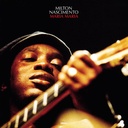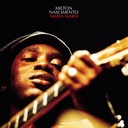TRACKLIST
A1 Maria Maria
A2 Cozinha
A3 Pilar (Do Pilá)
A4 Trabalhos (Essa Voz)
B1 Lilia
B2 A Chamada
B3 Era Rei e Sou Escravo
B4 Os Escravos de Jó
B5 Tema Dos Deuses
C1 Santos Católicos X Candomblé (Raça/Tema dos Deuses/S. Francisco - Francisco/Sentinela)
C2 Pai Grande
C3 Sedução
D1 Francisco
D2 Maria Solidária
D3 De Repente Maria Sumiu
D4 Eu Sou Uma Preta Velha Aqui Sentada Ao Sol
D5 Boca a Boca
D6 Maria Maria (Nova Maria)
DESCRIPTION
Far Out Recordings proudly presents Milton Nascimento’s Maria Maria. Recorded in 1976 and unreleased until almost thirty years later, the album was written as the soundtrack to a ballet which dealt with the legacy of slavery in Brazil. Raw, atmospheric and emotionally charged, Maria Maria reveals one of Brazil’s greatest ever songwriters at his creative peak. Featuring an all-star cast of fellow Brazilian legends including Nana Vasconcelos, Joao Donato, Paulinho Jobim, and members of Som Imaginario, Maria Maria holds what Milton considers to be the definitive versions of some of his classic songs, including ‘Os Escravos De Jó’ and ‘Maria Maria’. Originally released in 2003 as a double CD package, with Milton Nascimento's 1980 follow up ballet soundtrack Ultimo Trem, Maria Maria will be available on vinyl for the very first time from December 2019, with Ultimo Trem set for vinyl release early 2020.
Milton Nascimento possesses one of the most immediately recognizable voices in Brazilian music: high and sweet and as breathtakingly sublime as that of any soul singer. It was this voice that the legendary Brazilian singer Elis Regina fell in love with back in 1964, having heard Milton perform his song ‘Canção do Sal (Sultry Song)’ at a private party in Sao Paulo. Ellis went on to record the song in 1967 -giving Milton his first hit in Brazil and beginning a career that has spanned over 50 years.
Born in Rio on the 26th October 1942, Milton moved with his adoptive parents at the age of 18 months to Tres Pontas, a rural town in the state of Minas Gerais, 500 miles north of Rio. He began his musical career as a young teenager, singing in a crooner style he learnt from listening to Brazilian singers and US groups such as The Platters on the radio. Hungry for more opportunities to perform, Milton moved to Belo Horizonte, the capital of Minas Gerais, at the age of twenty. By the beginning of the 60s Milton had made a name for himself both as an accomplished singer and guitarist.
Milton became part of a local network of musicians, film makers, dancers, theatre directors and writers that included the journalist and song writer Fernando Brant as well as lyricist Marcio Borges and his younger brother Lo Borges. Together these four wrote and produced what would become Milton’s milestone album, ‘Clube da Esquina (Club on the Corner)’. The originality of ‘Club da Esquina’ shaped the local scene, and it reflects the essence of ‘the Nascimento Sound’. Milton’s religious upbringing as an Afro-Brazilian Catholic saw him exposed to church choral music from an early age. His love of this genre of music is apparent in both his celestial falsetto and vocal choral arrangements. This collection also displays his early fascination with evocative, non-verbal, scat-style singing, spare, harmonic guitar work and local folk music, jazz and rock.
In 1976, Milton and Fernando Brant teamed up with a new contemporary dance company called Grupo Corpo, whose Argentinian choreographer Oscar Araiz, would become a collaborator with the two musicians. Together, they conceived a show based on the composite life story of the daughter of a black slave called Maria. Nascimento wrote music to Brant’s lyrics and “Maria Maria” was premiered in the main theatre of the Belo Horizonte Palacio das Artes that year. “Fernando wrote the lyrics for the ballet, but there were originally no lyrics for the theme song, “Maria Maria’”. Milton and Fernando worked on the lyrics together, basing them on folk stories about black women of the countryside. Adds Milton “These memories are mostly things that we witnessed – Fernando and I – rather than what we experienced ourselves.
Milton’s music is impressionistic, emotional and romantic. Relying on songs without lyrics as well as evocative vocalizing and choruses, Milton experimented heavily with Afro-Brazilian percussion and taped jungle sounds. His composing method for these recordings was highly unconventional: “I wrote the music for ‘Maria Maria’ in a tiny Rio apartment with friends and their kids running around and having fun! I love to be in noisy places, surrounded by people”, he says.
The music on ‘Maria Maria’ was performed by an impressive group of young musicians who are today household names in Brazilian music, including Naná Vasconcelos (percussion and effects), Toninho Horta (guitars) and Paulo Moura (sax). Several vocalist including Naná Caymmi, Fafá de Belém, Beto Guedes, and Milton himself, had hits in years to come with reworkings of these songs.
Milton says his compositions follow his visions “like a movie”, and he believes that reflects his long love affair with cinema. “I only began composing because of enjoying the movies so much,” he says. “I wrote my first song “Peace for the Coming Love” after seeing ‘Jules et Jim’ (the cult 60s French film directed by François Truffaut), with my friend Marcio Borges. We went early in the morning and watched it four or five times in a row, then went to Márcio’s home and wrote the song.”
The songs also include solo spoken passages set to music, clearly influenced by this style of French art cinema. On the title track, Maria’s story is narrated and translated to music through the use of African Percussion, drums and metal signifying the field slave tools of the day. ‘Trabalhos (Works)’ runs to work rhythms and whipcracks: no words, just pain. ‘Lília’ documents the beating of the slave woman. After ‘A Chamada (The call)’ and the triumphant ‘Era Rei e Sou Escravo (I was a king now I am a slave’ things begin to turn and Milton employs tropical jungle cries to symbolize freedom. ‘Santos Catholicos x Candomble (Catholic Saints vs Candomble)’ represents the battle between African and European religions through the music of both sides. Milton’s heavenly falsetto pours into ‘Francisco’ and ‘Pai Grande (Great Father)’ and the outstanding ‘Eu Sou Uma Preta Velha Aqui Sentada no Sol (I’m an old black lady, sitting under the sun)’ conjures images of an old woman sitting deep in the forest, her memories painted in drums, piano and voices





